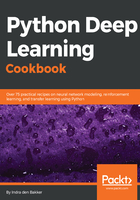
上QQ阅读APP看书,第一时间看更新
How to do it...
- Import libraries and dataset:
import numpy as np
from sklearn.model_selection import train_test_split
import matplotlib.pyplot as plt
# We will be using make_circles from scikit-learn
from sklearn.datasets import make_circles
SEED = 2017
- First, we need to create the training data:
# We create an inner and outer circle
X, y = make_circles(n_samples=400, factor=.3, noise=.05, random_state=2017)
outer = y == 0
inner = y == 1
- Let's plot the data to show the two classes:
plt.title("Two Circles")
plt.plot(X[outer, 0], X[outer, 1], "ro")
plt.plot(X[inner, 0], X[inner, 1], "bo")
plt.show()

Figure 2.5: Example of non-linearly separable data
- We normalize the data to make sure the center of both circles is (1,1):
X = X+1
- To determine the performance of our algorithm we split our data:
X_train, X_val, y_train, y_val = train_test_split(X, y, test_size=0.2, random_state=SEED)
- A linear activation function won't work in this case, so we'll be using a sigmoid function:
def sigmoid(x):
return 1 / (1 + np.exp(-x))
- Next, we define the hyperparameters:
n_hidden = 50 # number of hidden units
n_epochs = 1000
learning_rate = 1
- Initialize the weights and other variables:
# Initialise weights
weights_hidden = np.random.normal(0.0, size=(X_train.shape[1], n_hidden))
weights_output = np.random.normal(0.0, size=(n_hidden))
hist_loss = []
hist_accuracy = []
- Run the single-layer neural network and output the statistics:
for e in range(n_epochs):
del_w_hidden = np.zeros(weights_hidden.shape)
del_w_output = np.zeros(weights_output.shape)
# Loop through training data in batches of 1
for x_, y_ in zip(X_train, y_train):
# Forward computations
hidden_input = np.dot(x_, weights_hidden)
hidden_output = sigmoid(hidden_input)
output = sigmoid(np.dot(hidden_output, weights_output))
# Backward computations
error = y_ - output
output_error = error * output * (1 - output)
hidden_error = np.dot(output_error, weights_output) * hidden_output
* (1 - hidden_output)
del_w_output += output_error * hidden_output
del_w_hidden += hidden_error * x_[:, None]
# Update weights
weights_hidden += learning_rate * del_w_hidden / X_train.shape[0]
weights_output += learning_rate * del_w_output / X_train.shape[0]
# Print stats (validation loss and accuracy)
if e % 100 == 0:
hidden_output = sigmoid(np.dot(X_val, weights_hidden))
out = sigmoid(np.dot(hidden_output, weights_output))
loss = np.mean((out - y_val) ** 2)
# Final prediction is based on a threshold of 0.5
predictions = out > 0.5
accuracy = np.mean(predictions == y_val)
print("Epoch: ", '{:>4}'.format(e),
"; Validation loss: ", '{:>6}'.format(loss.round(4)),
"; Validation accuracy: ", '{:>6}'.format(accuracy.round(4)))
In the following screenshot, the output during training is shown:

Figure 2.6: Training statistics